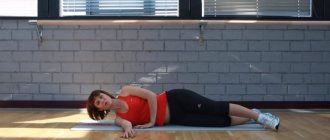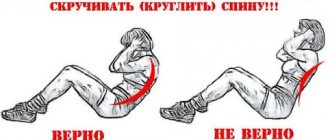Another thing is pain in the back and neck associated with osteochondrosis. It is possible and necessary to fight them. And there are many ways to do this.
Our expert is a neurologist of the highest category Marina Shakarova .
Pain in the lower back affects up to 80% of people. Moreover, recently, not only older people, but also young people have been suffering from this misfortune. According to statistics, this is the second most common reason for visiting a doctor after colds and acute respiratory viral infections. And among the reasons for hospitalization, acute back pain takes an “honorable” seventh place.
But due to osteochondrosis, it is not only the lower back that can cause concern. In 46% of people, pain occurs in the lower cervical spine, and in 29% - in the upper cervical spine. The thoracic region suffers much less frequently – it accounts for only 2%.
All ages are susceptible to osteochondrosis
The more a child turns his head, the less chance he has of developing osteochondrosis of the cervical spine in the future. However, even active, strong and trained people find it very difficult to avoid meeting such a powerful enemy of the human race as osteochondrosis.
By the age of forty, more than 70% of the population is very familiar with it. In total, 85% of the modern population of the Earth are victims of osteochondrosis. Such a catastrophic prevalence of the disease is ensured by living conditions in all countries, both rich and poor.
If a person eats poorly and monotonously and works hard, this creates an ideal environment for the development of osteochondrosis. If a person is overweight (or, moreover, obese) and leads a sedentary lifestyle, this creates even more ideal conditions for osteochondrosis. If a person spends a lot of time in transport, he cannot avoid osteochondrosis at all.
Thus, both the poor and the rich are equally susceptible to this serious disease of the spine and joints.
Massaging the collar area
If neck pain and headaches occur, in addition to neck exercises for osteochondrosis, massage of the muscles of the neck, trapezius muscle and, in general, the entire collar area can significantly help.
Often, after a long static position of the neck - while driving, sitting at the computer, unpleasant sensations appear and the neck becomes numb. As a result, it becomes difficult to remember anything, concentration and thought processes deteriorate.
This happens because the brain does not receive enough nutrition, in particular oxygen. After such a massage, in most cases, the spasm of the neck muscles is relieved, which has a beneficial effect on the vessels located there, including the vertebral arteries.
The massage is carried out by a third party, so you need to ask someone to do it - a relative or friend. The massage is performed in the following sequence :
- The patient sits on a chair, and it should be possible to rest the patient’s hands on something, for example, on a table. It is not necessary to use massage oils, but it is better to remove the patient’s outer clothing. First, a thorough massage of the trapezius muscles and long extensors of the neck is performed. It is necessary to grab the trapezius muscles with both hands and pull them slightly back from the collarbone. You need to massage until there is good redness in order to get enough blood into this area. It is worth noting here that if a person has very tense muscles, then the whole massage process will be somewhat painful for him, but here you need to be patient, and the presence of pain is not something terrible.
- After the trapezius muscles are warmed up, you can move on to the neck muscles. It is necessary to grab the long muscles of the neck, which are located just below the back of the head, with both hands, and then also make pulling movements until they are completely relaxed. Here, too, pain may occur that you will have to endure. If a person has any serious disorders in the cervical spine, for example a hernia, then all manipulations should be done extremely carefully.
- The third stage in the massage procedure will be massaging the lateral muscles of the neck. To do this, you need to slightly tilt the patient's head to the side, and then begin massaging this area. The technique for massaging the lateral muscle is the same - by pulling and holding it. The same is done on the other side.
Physical education must be correct
You need to start the fight against osteochondrosis at a very early age and not stop it throughout your life. Unfortunately, at the present stage, the attention paid to this problem in kindergartens and schools is completely insufficient.
But the results of medical examinations are simply horrifying: for example, among elementary school students, 30% of children have problems with the musculoskeletal system, and among high school students this percentage reaches 95%. That is, the new generation is almost entirely affected by diseases of the spine and joints, and cervical osteochondrosis accounts for at least 30%.
Very simple therapeutic exercises that need to be performed, adhering to the following rules, help to resist this destructive process:
- a set of exercises for osteochondrosis of the neck must be performed several times every day. The minimum schedule for regular exercise: in the morning after waking up and in the evening before bed.
- When working sedentarily, the simplest exercises should be performed every hour. This is especially important for those who work on a computer.
It should be emphasized that if cervical osteochondrosis is caused not by a lack of movement and sedentary work, but, on the contrary, by excessive physical activity, then to combat it it is necessary to find a way to reduce the load. Additional exercises in such a situation are pointless.
Danger of chondrosis
As a rule, most pain in the neck and collar area is caused by cervical osteochondrosis. Less commonly, the cause of pain is myositis, that is, inflammation of the surrounding muscles. Osteochondrosis is not only a disease of adults; it can even develop in children six years of age and older.
The effect of the disease on the body
Cervical osteochondrosis primarily affects the brain due to infringement of the vertebral arteries. Due to the fact that the vertebral arteries supply blood mainly to the posterior parts of the brain, characteristic symptoms will develop, namely :
- occipital headaches;
- visual impairment and diplopia;
- memory impairment;
- impaired coordination of movements;
- hearing loss, which may be accompanied by tinnitus;
- pain at the hair roots when touched, as well as hair loss;
- numbness, paresthesia (usually in the upper extremities in the area of the thumb and index fingers) and impaired fine motor skills;
- shoulder pain.
The cervical vertebrae are located one above the other in a stepped order, that is, slightly tilted forward.
With any displacement relative to each other, compression or irritation of the vertebral arteries that are located next to the vertebrae, namely in the foramina of the vertebral processes, easily occurs.
An approximate set of exercises for the neck
Most of these exercises are so simple that they can be performed not only at home, but even in the office workplace, because they do not attract outside attention at all.
- Place your hand on your forehead and completely relax your neck muscles. The hand should feel the heaviness of the head (the weight of the head is quite large - about 5 kg). Hold your head on your hand for 2-3 minutes.
- Place your palm around the back of your neck, tilt your head back and relax your neck muscles. Let your head rest in this position for 2-3 minutes. Another option is to support the back of your head with your hands.
- Slowly tilt your head to one side, then to the other, trying to touch your ear to your shoulder. Movements should be slow and smooth. There should be no pain or dizziness.
- Tilt your head forward and back until it stops.
- Slowly turn your head to the right and left.
- Gently make circular movements with your head.
Elements of this therapeutic exercise can be performed in literally any environment. The benefits of these seemingly primitive movements are actually enormous. They increase blood flow in the neck muscles and prevent congestion from developing. At the same time, the intervertebral discs receive proper nutrition, and degenerative processes in them either do not develop at all or are suspended.
How to deal with osteochondrosis: tips
Exercising for cervical osteochondrosis at home is a worthy addition to the treatment of the disease. It is important that it be systematic. How often you need to do exercises and for how long should be determined by a specialist. In addition, other recommendations regarding the fight against the disease must be taken into account.
Initially, you need to reconsider your lifestyle. Of course, most of us cannot escape sedentary work, but it’s worth taking breaks at least sometimes and letting our muscles warm up. In general, those who suffer from symptoms characteristic of osteochondrosis should make friends with sports. Do morning exercises, go swimming or any other sport - physical activity is the main guarantee of health. Also try to walk more.
A specialist may prescribe medications, such as pills or injections. Please note that you cannot self-medicate - only a doctor can determine what will help specifically in your case. These can also be topical agents, for example, gels or ointments to relieve unpleasant symptoms. You will also need to review your diet and take additional vitamins.
The importance of physiotherapy for osteochondrosis is great. In addition to exercise, which we have already discussed, acupuncture, manual therapy, massage and self-massage can help. Remember that only a doctor should prescribe adequate treatment measures.
Finally, we suggest watching a video of exercises for osteochondrosis of the cervical spine.
A few important notes
Healthy people can choose exercises for prevention at their own discretion and perform them with a large amplitude. But if the first symptoms of cervical osteochondrosis have already appeared and the diagnosis has been made, then a vertebrologist should draw up a set of physical activities and develop an exercise technique during an individual consultation.
- During an exacerbation of the disease or in the presence of severe pain, exercise is not recommended, as this can lead to a worsening of the condition or even destruction of the disc.
- Performing the movements should bring relief. There should be no pain or discomfort during gymnastics. If pain or discomfort occurs, then the exercise should be stopped. If discomfort occurs regularly during gymnastics, then it is necessary to choose another set of exercises.
- It is necessary to maintain correct posture everywhere and always.
- All movements should be as smooth as possible. Jerks, sharp turns, fast rotations are prohibited.
- Do not allow dizziness, crunching or clicking in the joints to occur.
- The exercises can be performed either sitting on a comfortable chair (on the floor, bed) or standing on a flat surface. It is not recommended to perform exercises on the go. If you are driving, then performing exercises is strictly prohibited.
Neck massage for osteochondrosis of the cervical spine and the appearance of withers
Neck exercises help get rid of pain, osteochondrosis and withers. To achieve a greater training effect and for pain, you should supplement the practice with massage.
How to massage yourself:
- Sit comfortably on a chair, bring your neck to a static position and completely relax. Hands should be lowered and free, without tension.
- Massage the chest, back, smoothly move to the forearm, neck, and back of the head. Every movement should be smooth and relaxing. The muscles are kneaded smoothly, without making sudden movements. Massage should be done from top to bottom.
- After completing the session, shaking movements are performed to help consolidate the achieved effect.
In addition to the described method of influence, you can use other techniques, such as: vacuum massage, acupressure and Thai.
The specialist in the following video demonstrates how to do a vacuum massage from the withers using the Revitonics system.
To prevent the problem of neck pain and its diseases from arising, you should perform preventive measures: douse yourself with cold water and arrange your sleeping place in such a way that the whole body is in the most comfortable position during sleep. You need to choose a firm mattress.
When organizing your workplace, the furniture should fit you so that when sitting on a chair you don’t have to lean towards the computer monitor and your shoulders don’t strain or rise when working.
Tags: gymnastics, health, spine
- Related Posts
- Exercises for the neck by Dr. Bubnovsky with a description of their implementation
- A set of exercises for correct straight posture, to open the thoracic spine
- Neck exercises from Dr. Shishonin, description, video, reviews
« Previous entry
Neck exercises have contraindications
If you have never done neck exercises before, it is best to consult your doctor before trying these exercises, even if nothing worries you. The fact is that despite their simplicity, neck exercises still have a number of contraindications. These include:
- exacerbation of osteochondrosis;
- herniated intervertebral discs;
- high-grade hypertension;
- high blood pressure;
- conditions accompanied by elevated temperature;
- oncological diseases.
Indications for use
It is recommended to perform exercises only when the acute pain threshold has been eliminated. Indications for neck exercise therapy are:
- cervical osteochondrosis;
- degenerative processes of bone and cartilage tissue;
- curvature of the spine, in which the load on the neck is distributed unevenly;
- Bekhterev's disease;
- dislocation and subluxation of the cervical vertebrae;
- spondylolisthesis.
Expert opinion
Filimoshin Oleg Alexandrovich
Neurologist, city clinic of Orenburg. Education: Orenburg State Medical Academy, Orenburg.
In order not to harm your own health, a physical therapy specialist shows you the necessary exercises, and then asks you to follow all his recommendations.
An important aspect is systematicity . You should not skip classes or do them too intensely, which can provoke the opposite effect.
Start your day with neck exercises
The mood with which we get up from sleep in the morning largely determines our well-being for the whole day ahead. Most pain attacks associated with cervical osteochondrosis manifest themselves in the very morning, so exercise immediately after waking up is very important.
These exercises are performed while a person is still lying in bed, and help not only to tidy up the neck, but also to drive away the remnants of sleep and to cheer up well.
The recommended repetition of each exercise is 5 times.
- When you wake up, the first thing you should do is lie on your back, stretching out to your full height, and forcefully press your head into the pillow. You need to tense your muscles smoothly.
- Licking on your back, raise your head. The pillow can be removed to perform this exercise.
- Lie on your side and raise your head from the pillow (mattress).
- Lie face down, clasp your hands at the back of your head, firmly rest your forehead on the pillow (or mattress). Raise your head, while creating a force with your hands to prevent this movement.
- Starting position, as in point 4. Rest your forehead on the pillow and carefully press your head into the pillow.
Prevention of cervical osteochondrosis
Despite sedentary work and the prevalence of osteochondrosis, one should not assume that the disease cannot be prevented. Can! Will exercise be effective for osteochondrosis? Definitely yes! You just need to follow some recommendations:
- Control your posture in the office, at your desk, in front of the computer;
- Visit an orthopedist regularly and have your spine corrected;
- Avoid accumulating excess weight;
- Sleep on an orthopedic mattress and a low pillow;
- Do yoga, swimming;
- Avoid sudden head movements;
- Eat more vegetables, fruits, dairy products, nuts; give up cigarettes and alcohol.
Follow these tips, introduce therapeutic exercises and regular physical activity into your life. Exercise for spinal osteochondrosis is useful both for preventing the development of the disease and for its treatment. But don't forget to consult your doctor. Only he will be able to select individual exercises based on the analyzes and research performed.
Dear readers, that’s all for today, leave your opinion about this article in the comments, does neck exercises help you with osteochondrosis?
Basic exercises
Exercises belonging to the basic group are prescribed by doctors in almost all cases. They should not be performed only during exacerbation and severe pain.
To achieve a therapeutic effect, the basic complex must be performed daily, at least twice a day.
The number of recommended repetitions of each movement is 15 times.
- Wrap your arms around your neck, making a corset out of your palms. Tilt your head in all directions.
- Perform head tilts in different directions now without arms.
- Press your palm onto your forehead and tense your neck, as if you are overcoming the resistance provided by your hand. Perform the exercise for 20 seconds.
- Repeat the same, placing your palm on the back of your head; on the left temple; on the right temple.
- Cup your temples with your palms and carefully turn your head with your hands in different directions. The neck muscles should be relaxed.
- Tilt your head back and turn it in different directions.
Why does your neck hurt: about the withers, osteochondrosis and hypertension
As a result of prolonged stay in an uncomfortable position, a layer of fat begins to be deposited in the area of the seventh cervical vertebra. In common parlance it is called the withers or “widow’s hump.” This pathology is dangerous to health and affects the functioning of various body systems:
- First of all, the entire collar area suffers, which leads to the development of osteochondrosis of the cervical spine;
- Blood flow in this department slows down and leads to the deposition of fat cells;
- At a late stage of the disease, a person feels severe pain, which is caused by vascular syndrome.
People say that people with withers solve all complex issues on their own, without outside help. This is not to say that there is no truth in this statement, however, this problem occurs as a result of weakening muscles due to frequent sitting slouched and a sedentary lifestyle.
A strong muscular corset of the spine contributes to its health. Otherwise, the nerve endings extending from the spinal cord are compressed, and the blood supply deteriorates, preventing the brain from receiving all vital substances.
A compressed artery causes hypertension, which can cause a stroke or heart attack. To prevent them, it is recommended to regularly perform neck exercises.
When the first signs of chondrosis appear, you should consult a doctor who will offer the optimal solution to the problem. Thanks to timely treatment from the initial stage of the disease, its serious consequences can be avoided.
Symptoms of osteochondrosis include:
- Pain in the back of the head, shoulders, and arms. It has an aching character, arising from the side or back. It is very difficult to turn your head;
- A patient with osteochondrosis experiences frequent dizziness, ringing in the ears, and loss of balance while walking;
- Weakness occurs in the upper limbs, face and neck.
The disease at an early stage can be treated with neck exercises for osteochondrosis. Traditional treatment is used only when hard lumps are detected in the collar area.
Additional exercises
The number of additional exercises is very large. This group includes exercises for all parts of the spine, as well as for developing the muscles of the arms and legs.
The simplest and most effective include the following:
- Stand up straight, stretch your relaxed arms along your body. Keeping your head straight, raise your shoulders up, trying to touch your ears.
- Stand up straight. Perform rotational movements with your shoulders. In this case, the arms can be in different positions: along the body, on the belt, bent at the elbows.
Lie on your back. Pull your knees to your chest, clasp them with your arms and try to pull your head towards them. In yoga, this pose is called pavanamuktasana (wind release pose).
Lie on your stomach. Try to lift your upper body by arching your back and leaning on your elbows, and then straightening your arms. This is the so-called Bhujangasana, or cobra pose. You can read more about this extremely healthy asana here.
It should be noted that yoga is ideal for the prevention of osteochondrosis, and if there are no contraindications, you can master any asanas - they will definitely benefit the neck and the entire spine.
What else can you do to help yourself?
Neck exercises are very effective and can produce excellent results when performed regularly. But in order to prevent further development of the disease, gymnastics alone is not enough.
For the treatment and prevention of cervical osteochondrosis, weight is of great importance. Even a few extra pounds lead to the fact that the load on the spine increases on a gigantic scale, so you need to do your best to reduce weight and prevent it from increasing.
To restore damaged cartilage tissue, the body must produce its own collagen, and for this it needs building material. Therefore, the diet must necessarily include dairy products, fish, lean meat, nuts, eggs, cabbage, and legumes.
But sugar should be sharply limited, since, among other things, it helps to wash out calcium from the body and accelerate degenerative processes in bone tissue.
And in conclusion, let's watch a short video showing how to perform a basic set of exercises for the neck.
And now, dear readers, I would be very pleased if you would share links to the article with your friends on social networks and express your opinion in the comments.
Exercise therapy for the neck according to Bonina on video
The information is either out of date or no longer relevant.
- 5
- 4
- 3
- 2
- 1
Main advantages:
- For those who want to know the secrets of a healthy neck. For those who want to overcome cervical osteochondrosis once and for all. For those who suffer from lower back pain and who want to learn the secrets of a healthy lower back. For those who want to learn a set of exercises (6 simple exercises) for the neck and lower back.
- For those who want to cure thoracic osteochondrosis once and for all.










